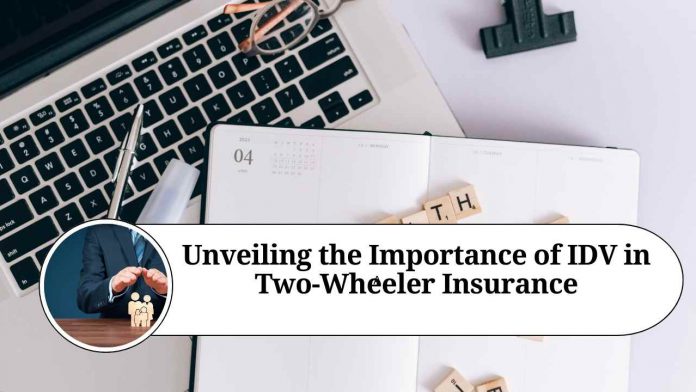Introduction
When it comes to protecting your two-wheeler from unforeseen circumstances, having comprehensive insurance coverage is essential. One crucial aspect of two-wheeler insurance is the Insured Declared Value (IDV). IDV plays a significant role in determining the financial protection offered by your insurance policy. In this blog, we will delve into the world of IDV and shed light on its importance in two-wheeler insurance.
Understanding IDV:
IDV, or Insured Declared Value, is the maximum amount that an insurance company will compensate you in the event of a total loss or theft of your two-wheeler. It represents the current market value of your vehicle after accounting for depreciation. The IDV serves as the basis for calculating the premium you need to pay for your two-wheeler insurance policy.
The Significance of IDV:
Accurate Compensation: The IDV ensures that you receive a fair and appropriate compensation amount in case of total loss or theft of your two-wheeler. It takes into account the depreciation value of your vehicle, which accounts for wear and tear over time.
Premium Calculation: The IDV directly affects the premium amount of your two-wheeler insurance policy. As a general rule, the higher the IDV, the higher the premium. It is crucial to strike a balance between the IDV and the premium to ensure adequate coverage without overpaying.
Basis for Claims Settlement: In the unfortunate event of an accident, the IDV acts as a benchmark for calculating the claim amount. The insurance company typically reimburses the cost of repairs based on a percentage of the IDV. Therefore, having an appropriate IDV value ensures that you are adequately compensated for any damages incurred.
Factors Affecting IDV:
Several factors influence the calculation of IDV:
Age of the Vehicle: As a vehicle ages, it undergoes wear and tear, which leads to a decrease in its market value. Consequently, the IDV decreases with the age of the two-wheeler.
Vehicle Make and Model: The brand, model, and variant of your two-wheeler have an impact on its market value. Popular and well-maintained models tend to have a higher IDV compared to less-known or older models.
Depreciation: Depreciation is a significant factor affecting the IDV. As per the Insurance Regulatory and Development Authority of India (IRDAI) guidelines, the depreciation rates for different vehicle parts are predefined and used to calculate the IDV.
Tips for Determining the Right IDV:
Research and Evaluation: Conduct thorough market research to understand the current market value of your two-wheeler. This will help you estimate an appropriate IDV for your vehicle.
Consult with Insurers: Seek guidance from insurance professionals or use online tools provided by insurance companies to calculate the IDV accurately. Their expertise will assist you in determining the optimal IDV for your two-wheeler.
Balancing Coverage and Premium: Strive for a balance between a higher IDV and a reasonable premium. While a higher IDV offers better coverage, it can also increase the premium amount. Consider your budget and coverage requirements to strike the right balance.
Conclusion
The Insured Declared Value (IDV) is a vital aspect of two-wheeler insurance that directly affects the financial protection offered by your policy. By accurately determining the IDV, you can ensure fair compensation in case of a total loss or theft of your two-wheeler. Additionally, understanding the factors influencing IDV and following the tips mentioned above will help you make informed decisions while choosing the right insurance coverage for your beloved two-wheeler. Remember, the right IDV is the key to a secure and hassle-free riding experience.
Read more useful content:
Frequently Asked Questions (FAQs)
Q1: What is IDV in two-wheeler insurance?
A1: IDV stands for Insured Declared Value. It is the maximum amount that an insurance company will compensate you for the loss or theft of your two-wheeler. It represents the current market value of your vehicle after accounting for depreciation.
Q2: How is IDV calculated in two-wheeler insurance?
A2: IDV is calculated based on the age of the vehicle and its market value. Insurance companies follow predefined depreciation rates to determine the IDV. The older the vehicle, the higher the depreciation and lower the IDV.
Q3: Why is IDV important in two-wheeler insurance?
A3: IDV is important because it determines the maximum amount you will receive as compensation in case of total loss or theft of your two-wheeler. It also influences the premium amount you need to pay for your insurance policy.
Q4: Can I choose the IDV for my two-wheeler?
A4: No, the IDV is determined by the insurance company based on predefined depreciation rates and the market value of the vehicle. However, you can evaluate the IDV offered by different insurers and choose the one that provides the best value for your two-wheeler.
Q5: How does IDV affect the premium of two-wheeler insurance?
A5: The IDV directly affects the premium amount. Generally, a higher IDV leads to a higher premium. It is important to strike a balance between the IDV and the premium to ensure adequate coverage without overpaying.
Q6: Can I insure my two-wheeler for an IDV higher than its market value?
A6: No, you cannot insure your two-wheeler for an IDV higher than its market value. The IDV represents the maximum amount the insurance company will compensate you, and it is based on the market value of the vehicle.
Q7: Is it advisable to reduce the IDV to lower the premium?
A7: Reducing the IDV may lower the premium, but it also reduces the amount of compensation you will receive in case of a total loss or theft. It is important to maintain an appropriate IDV to ensure adequate coverage for your two-wheeler.
Q8: Can I modify the IDV during the policy term?
A8: No, the IDV remains constant throughout the policy term. It is determined at the time of policy inception and remains unchanged unless you renew your policy or make modifications as per the insurance company’s guidelines.
Q9: What should I consider when determining the right IDV for my two-wheeler?
A9: When determining the right IDV, consider factors such as the current market value of your vehicle, its age, depreciation rates, and your budget. Strive for a balance between a higher IDV and a reasonable premium that suits your coverage requirements.
Q10: Can I negotiate the IDV with the insurance company?
A10: The IDV is generally non-negotiable as it is based on predefined depreciation rates and market values. However, you can compare IDVs offered by different insurers and choose the one that provides the best value for your two-wheeler.




















